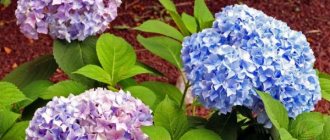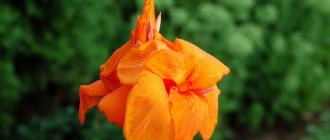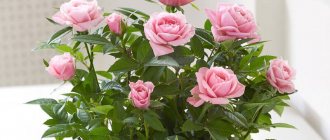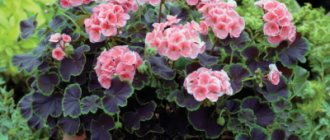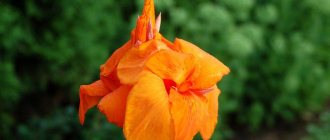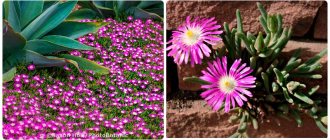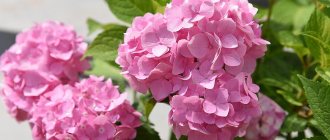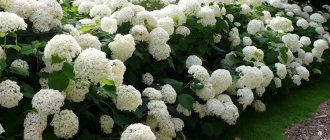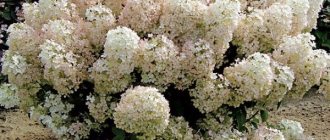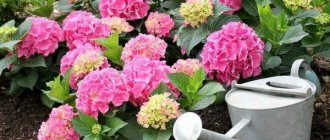Plants » Flowers
0
363
Article rating
Kira Stoletova
In growing garden flowers, soil is of no small importance. The development of the plant and its flowering depend on its structure. The soil for hydrangea must also meet certain requirements, otherwise it is quite difficult to grow it in full accordance with the varietal description.
Land for hydrangea
Hydrangea: description, photo
The flower got its name for its moisture-loving nature. From Latin the designation “hydrangea” is translated as a combination of “water” and “jug”. Officially, hydrangea is called hydrangea. In Europe, the name was consonant with a common female name, so there were many myths about whom the enamored botanist Fliebert Commerson gave the honor of being the founder of the name of the flower.
There is a popular legend about the Emperor of Japan, who liked the elongated white panicles and used them to apologize to his lady. Since then, the hydrangea variety has come to be personified with cordiality, sincerity of feelings, and a manifestation of complacency.
garden hydrangea
These garden flowers are used as the main element of flower arrangements, borders, and planted in areas to divide space while simultaneously marking the territory with abundant inflorescences of different shades. They coexist with thujas and juniper trees, but do not like to grow in the shade of tall coniferous trees.
Hydrangeas are represented by several species: some of them belong to the shrub type, some grow like trees, and the rest develop like vines. Description of the classic type of hydrangea:
- The stems grow from 1 to 3 m. In some varieties, the height can reach 10 m.
- The leaves are semi-oval with pointed tips. The surface of the leaves is glossy, rich green in color.
- Flowers are collected in inflorescences-corymbs or panicles. The diameter of the inflorescences can reach 20 cm. The shade of the petals depends on the species characteristics. White and pink are considered classic colors.
- After ripening, the fruits are collected in a simple capsule, which is formed at the site of the inflorescence fading.
The genus has several species that differ from each other.
| View | Characteristic |
| tree-like | A shrub that stretches up to 3 m. Small white flowers reach 2 cm in diameter, form scutes up to 20 cm in size. It begins to bloom in mid-summer, feels comfortable in the temperate climate zone. |
| Paniculate | Shrubs or trees stretch up to 10 m. The difference from other subspecies is that small flowers are collected in inflorescences - panicles. |
| large-leaved | The bushes grow up to 4 m. Flowers on thyroid inflorescences can be blue, pink or white. This is the only species that can change the shade of the petal after changing the composition of the earth. Large-leaved hydrangias are often chosen for growing as a houseplant. There are more than 80 varieties of indoor hydrangeas. |
Hydrangea is grown on clubs as a garden type or on a windowsill as a houseplant. Flowering begins with the onset of summer and continues until the autumn cold. The inflorescences, corymbs or panicles, make the hydrangea visible from afar. The shades of the petals attract gardeners. Hydrangeas can decorate flower beds and make any windowsill look elegant.
Hydrangea care
Grooming rules are linked to specific cultural preferences. Garden hydrangea requires regular watering and a special substrate. In addition, she loves light and warmth, and is also picky about her neighbors.
Placement
For hydrangea, choose places near a hedge, fence, or on the south side of the house. The open area should not be shaded by the crowns of tall trees. Young bushes must have enough space to grow. Neighboring crops are chosen taking into account that the roots do not grow in width and do not compete for food and moisture. Avoid planting in areas with strong winds. Bushes can grow up to 4 m, so a strong wind can break branches and damage inflorescences.
Lighting
An important point when choosing a location. The shrub is demanding of light: in the morning it needs full sunlight, in the afternoon partial shade is preferable. The scorching sun causes the flowers to shrink and wilt.
Watering
Hydrangea needs regular watering. In summer, when the air temperature exceeds + 27-28°, watering is daily. The soil is moistened in the morning by root watering. In the evening, water the bushes by spraying or sprinkling. The bushes are not resistant to drought, and also do not tolerate stagnant water, so planting in lowlands where moisture accumulates is excluded.
Feeding
To establish lush flowering, follow the feeding schedule. In spring, the soil is fertilized with organic matter. Then mineral mixtures are added to increase the green mass and form buds. At the peak of flowering, organic matter is added again. The type of mixture and frequency of fertilizing completely depend on the composition of the soil. Some elements of mixtures affect the alkalization of the environment, which is detrimental to all species, so avoid adding dolomite, limestone, and chalk.
Trimming
One of the important conditions for crop care. In the spring, formative pruning must be carried out. The buds of young bushes are cut off, this stimulates budding; old bushes are given rejuvenating pruning. Bushes are often shaped like balls (large-leaved, tree-like) or elongated candles (paniculate).
Mulching
Agrotechnical practices carried out to retain moisture inside help to simultaneously maintain soil acidity levels. For a layer of mulch, use pine needles, pine bark or high-moor peat.
Loosening
Regular loosening of the top layer helps to increase the conductivity of air and moisture, which is especially important for the crop. The soil under the bushes is loosened after heavy watering, after rains, and combined with changing the layer of mulch.
Reproduction
The bushes are divided, propagated by cuttings or layering. Planting rooted cuttings begins with preparing the soil.
Advice! The bushes are pruned in stages: the main pruning is done in the spring, and adjustments are made in the fall. In summer, branches that develop inside the bush are pruned.
Types, varieties
In total, about 80 species of large-leaved hydrangea have been bred. Some varieties are grown only as indoor or greenhouse varieties due to their high light-loving properties and low winter hardiness, while others are successfully cultivated in the garden. Three remontant varieties are most popular among gardeners.
- "Avantgarde". The bush has very large, dense inflorescences with a diameter of up to 30 cm. The petals of the lush caps amaze with a variety of shades; the petals come in white, pink, green, lilac and blue.
- "Blushing Bride Endless Summer." This broadleaf hydrangea is popularly called the “blushing bride.” Its buds are initially white, then become semi-double and gradually turn pink.
- "Blaumayse". The compact bush grows up to 120 cm, blooms from July, delighting the eye with lacy inflorescences up to 15 cm in diameter. The petals are bluish in color and can turn lilac or pinkish when planted in different soils. Flowering occurs only on last year's shoots, so shelter for the winter is required.
Thanks to the efforts of breeders, new varieties that are more winter-hardy began to appear in Russian gardens since 2000:
- “Endless Summer” (“Endless Summer”);
- “Red Sensation” (“Red Sensation”);
- "Early Sensation"
- varieties of the Forever series;
- series “Yu-and-Mi” with double flowers;
- remontant species - “Firewax White”, “Bloom Star”, “Coco Blanc”, “Mini Penny”, “Ripple”.
Lovers of pink double inflorescences should choose the varieties “Expression”, “Hovaria Hanabi Rose”, “Peppermint”, “You & Me Love”. Connoisseurs of bluish colors will like the large-leaf varieties “Nikko Blue”, “Freepon”, “Mini Penny”, “Jomari”. Those who want to plant macrophila with multi-colored inflorescences should choose the varieties “Sweet Fantasy”, “Ramars”, “Expression”, “Freedom”, “Compeito”, “Shloss Wackerbarth”.
In the photo - large-leaved hydrangea Endless Summer
In the photo - large-leaved hydrangea Schneebol
In the photo - large-leaved hydrangea You & Me Together
What soil does hydrangea need?
Growing a unique ornamental shrub involves selecting the right substrate. The soil requirements of this shrub are called high. In large-leaved hydrangea, a close relationship is observed between the composition of the soil and the shade of the petals. If the soil is not fertilized enough or the acidity level changes, the plant may react by curling the leaves and dropping the flowers. The soil for a garden variety must meet several basic requirements.
Information! Lime, chalk or ash are not used to treat the planting area.
Acidity
This indicator depends on the course of natural processes and may change throughout the life of the flower. For hydrangea, soil with medium or weak acidity is suitable. The best option is to create soil with a level of 5 or 5.5 ph. Gardeners use special litmus testers to measure acidity levels. Experienced gardeners determine the level by the type and shade of the inflorescences.
Ease
Lightness is determined by the presence of sand particles as a percentage of the total mass, as well as by the indicator of plasticity, that is, the ability to maintain shape after external influence. The root system of shrubs requires light sandy loams with a plasticity number not exceeding 7 points.
Nutritional value
This is one of the important criteria for garden crops. The substrate with the required nutritional value is prepared 2-3 months before the main planting. For enrichment, equal amounts of chernozem, leaf and turf soil are used, coarse sand, humus, and the necessary fertilizing are added. This can be 2 parts organic and 2 parts superphosphate. The mixture is left in the holes prepared for the seedlings for 2-3 months so that the components mix. Flower growers begin preparing the substrate in the fall.
Water permeability
The root system needs regular watering. Hydrangeas need constant moisture; they are not resistant to drought. To do this, create a type of soil that facilitates the rapid passage of moisture.
Breathability
Soil ventilation is achieved by adding coarse sand. This technique not only allows air and water to pass through faster, but also promotes rapid evaporation and prevents waterlogging. The permeability index is further increased by regular loosening.
Features of cultivation
Large-leaved hydrangeas can hardly be called hardy, frost-resistant and undemanding. This species often suffers from various diseases and pests when grown in the garden.
- Chlorosis occurs when watering with hard water and planting in alkaline soil and manifests itself in yellowing of the leaves. They fight it by acidifying the soil with various additives.
- Downy mildew manifests itself in oily-yellowing spots; to combat it, the bushes are sprayed with fungicides and special preparations.
- Rust on hydrangea leaves is combated by spraying the green parts of the plant with copper sulfate.
- Bordeaux or Burgundy liquid helps get rid of septoria.
- Due to drought, spider mites appear on shrubs. They are destroyed with insecticide solutions.
- Plants are protected from mice and other rodents with traps and special preparations.
- Root rot is combated by drenching the soil with a solution of potassium permanganate.
- In the fall, preventive spraying is carried out with Bordeaux mixture to protect the branches from preheating and fungus.
Soil composition for garden hydrangea
Garden and indoor crops may prefer different soils. The composition also differs depending on the species and individual preferences.
Paniculata
Gardeners especially like this species for the splendor of its flowering and the formation of recognizable panicle inflorescences. For paniculate species, loams with sufficient acidity are selected. Bright, voluminous panicles appear on the bush when the soil consists of equal parts of brown earth, peat, spruce or pine compost.
Tree-like
This species is the least picky about the composition of the soil. The bush prefers loamy soils with a mandatory drainage layer. Tree hydrangea is not as afraid of calcareous deposits as other species. In order for the bush to grow properly, it is necessary to increase the acidity, that is, to acidify the soil artificially. For the tree-like variety, loose, breathable compounds with an acidity level of up to 6.5 ph and the mandatory addition of coniferous soil are chosen.
large-leaved
Large-leaved varieties are compact bushes that are used for planting in the first row of borders, as well as for decorating any personal plot. In addition, there are options for placing potted large-leaved hydrangeas on verandas or terraces to decorate the landscape.
soil for hydrangea planting
For planting large-leaved hydrangeas, places are selected next to heather crops, such as rhododendron, as well as conifers, such as thuja and juniper. The substrate for the large-leaved variety is prepared according to the formula with an equal amount of sand, turf, leaf soil, humus, and peat. The root system of this species quickly reacts to changes in acidity: it changes the color of the flowers.
Pests and diseases in the soil
Undisinfected soil becomes a breeding ground for pests that move onto the hydrangea and damage its integrity. Among the most common harmful insects found on plants are garden slugs, which eat the vegetative mass and lead to loss of decorativeness.
Soil for garden hydrangea
Treatment of the bush and the surface layer of soil with Molluscicide can cope with snails.
Fungal pathogens are capable of maintaining active life in the soil. Preventive spraying with fungicides will prevent the development of fungus.
Flower color depending on soil acidity
In large-leaved hydrangea, the shade of the petals changes after a change in soil acidity. Experienced gardeners experiment with indicators: they carry out acidification, they can artificially deoxidize the substrate. It is known that large-leaved shrubs grow on soil with acidity levels from 4 to 7.4 pH. If the acidic environment exceeds the last mark, the root system of the plant can be damaged.
The following dependence of the shade of small flowers on inflorescences on the level of acidity is characteristic of an ornamental large-leaved shrub:
- at 4 ph – purple petals;
- 4.5 ph – blue;
- from 5.1 ph – blue;
- at a level from 4.9 to 5.5 ph - from blue to pink color;
- from 6.5 ph - dark pink shade;
- 6.9 ph – pink;
- 7.4 ph - light pink.
Information! White flowers do not change color because they do not contain natural dyes.
Reproduction
Most often, paniculata hydrangea is propagated by cuttings and layering. The remaining cuttings with 4-5 buds after spring pruning are placed for two days in a weak Kornevin solution, after which they are planted on a school bed, burying the lower cut in loose acidic soil for two buds. Cuttings of paniculata hydrangea must be protected from bright sun, and the soil in the garden bed should be regularly moistened, not allowing it to dry out. As soon as young leaves appear on the cuttings, the shading is gradually removed. For the winter, the cuttings must be covered with spruce branches. Next summer, it is better to remove the first flower stalks so that the plant can devote all its energy to growing the root system. Cuttings are planted in a permanent place at the age of 4-5 years.
It is very easy to propagate paniculate hydrangea by layering: in the spring, a low-growing shoot of a young plant is bent to the ground, pinned to it and the place of fixation is covered with fertile soil or peat. The cuttings are watered throughout the season, covered with spruce branches for the winter, and next spring they are separated from the mother plant and transplanted to a school bed for growing.
How to acidify soil for hydrangea
Flower growers who are engaged in growing crops know their garden well and work with different types of soil. A beginner will not immediately understand the types of soils, but over time, you can achieve a real variety of colors in the flowerbed by selecting the components. To grow large-leaved hydrangea, they use techniques that help create an unusual appearance: on the one hand, the bushes are grown on acidic soil, on the other hand, an alkaline environment is used. This allows you to get bushes with flowers of different shades.
blue hydrangea
There are many ways to make acidic soil for hydrangeas. To regulate acidity, special testers are purchased that help track indicators and adjust the composition. The use of an electrolyte can acidify any soil. A solution of sulfuric acid is well suited, which, in addition to its main purpose of oxidation, activates metabolic processes inside the plant, promotes growth and development. For 1 liter, take 1 ml of electrolyte; for an adult bush, prepare about 5-6 liters of solution. Watering is carried out every 2 weeks.
To prepare an effective solution with citric acid, take 1 tsp. acid per 10 liters of water. Water the ground with a solution of water and table vinegar. For 100 g take 10 liters of water. When calculating, the use of 10 liters per 1 m² is usually taken as a basis. To make an acidic environment for flowers, follow the basic rules:
- Preparation for oxidation begins with composition analysis. A light and loose substrate can be easily restored to its proper form by adding organic matter. Clay and heavy bases are difficult to deoxidize with organic matter; watering with specially prepared solutions is suitable for them.
- Iron sulfate is added to clay and heavy bases. This is a substance that can provoke the necessary chemical reactions. The calculation is made taking into account the fact that 5 kg of iron sulfate reduces the acidity of 90 m per unit.
- Organic matter is added to soils with good drainage. The air permeability of the layers contributes to the active decomposition of the components and the concomitant deoxidation of the soil. Sphagnum makes the drainage layer; compost prepared according to a special scheme is suitable as organic matter.
- To increase the indicator, potassium aluminum sulfate is used. About 20-50 g of alum is added to the surface every 2-3 weeks. This method is suitable for creating an unusual shade of petals.
When carrying out these procedures, it is taken into account that alkaline watering, precipitation, and foliar treatment contribute to soil deoxidation.
Advice! Watering with solutions that help normalize the acidity level is carried out every 2 weeks.
Mineral fertilizer
One of the most important procedures is fertilizing the soil for hydrangea. You should fertilize two or three times during the season, late August at the latest.
Its main function is to provide the nutrients necessary for the proper growth and development of hydrangeas. The appropriate fertilizer must contain macro- and microelements necessary to produce the correct number of flower and leaf buds and to maintain long and intense flowering of the plant. In early spring, you should begin fertilizing the bush with a balanced grain hydrangea fertilizer. The composition of the universal plant food includes nitrogen, potassium, phosphorus and other microelements.
The second method of fertilization is additional acidification of the soil. The purpose of the procedure is to change the color of the flowers to a more intense color (the flowers become intensely blue). For this purpose, it is recommended to use fertilizers for acidophilic plants from early May to mid-August.
To prepare hydrangea for the winter, it is recommended to fertilize it with potassium and phosphorus at the end of summer. Delivery of these ingredients before winter will allow the hydrangea to properly prepare for the first frosts, and then for a more or less cold winter. In addition, potassium and phosphorus affect the formation of flower buds and stems.
What soil does indoor hydrangea need?
A pot with an indoor variety can decorate the window sills of a private house or apartment in a high-rise building. Caring for home crops is significantly different from maintaining garden shrubs. Mostly large-leaved hydrangeas are grown in pots, which explains the variety of color shades of the petals.
soil for hydrangea in a pot
For an indoor variety, the presence of a drainage system is considered an important maintenance condition. This is a kind of cushion on which soil with a sufficient level of acidity is placed.
Compound
Indoor hydrangea is a compact plant, not exceeding a height of 1 m. Beautiful clay pots are chosen for planting, as the flowers will decorate the house and will stand in plain sight. A clay container absorbs excess water well, eliminating shortcomings in care. A drainage layer of perlite or coarse sand is placed at the bottom. Then place soil consisting of leaf soil, peat and sand.
Which ready-made soil to buy
To plant indoor hydrogynea, purchase a ready-made substrate that is equally suitable for rhododendrons and azaleas. As a rule, it is sold in 10 liters, it has a classic composition:
- high peat;
- perlite, river sand (as a component to improve permeability);
- complex mineral fertilizer (to increase nutritional value).
The acidity level is on the border from 4.5 to 5 pH.
How to cook it yourself
You can prepare suitable soil for planting yourself, making it exactly what hydrangea needs. Coniferous needles and peat are used for mulch - these components successfully cope with creating the required acidity level. Take coarse sand, leaf soil, peat crumbs, and pine needles.
For the indoor variety, humus is not used. The substrate is prepared according to the classic formula: to 4 parts of leaf soil add 2 parts of turf and peat, 1 part of sand. The sand is calcined, small river stones for drainage are washed and dried. Pebbles are laid out at the bottom of the pot, then the substrate is added. After planting, the top layer must be loosened, which increases the level of breathability. Then the soil is mulched with fresh pine needles.
preparing soil for hydrangea with your own hands
Indoor hydrangea needs annual replanting after it reaches the mature age of 4 years. At the same time, it is taken into account that the root system is transplanted using the transshipment method, that is, it is transplanted into a new pot with the previous lump of earth.
Information! Drainage made from expanded clay or broken brick is not suitable for hydrangia.
